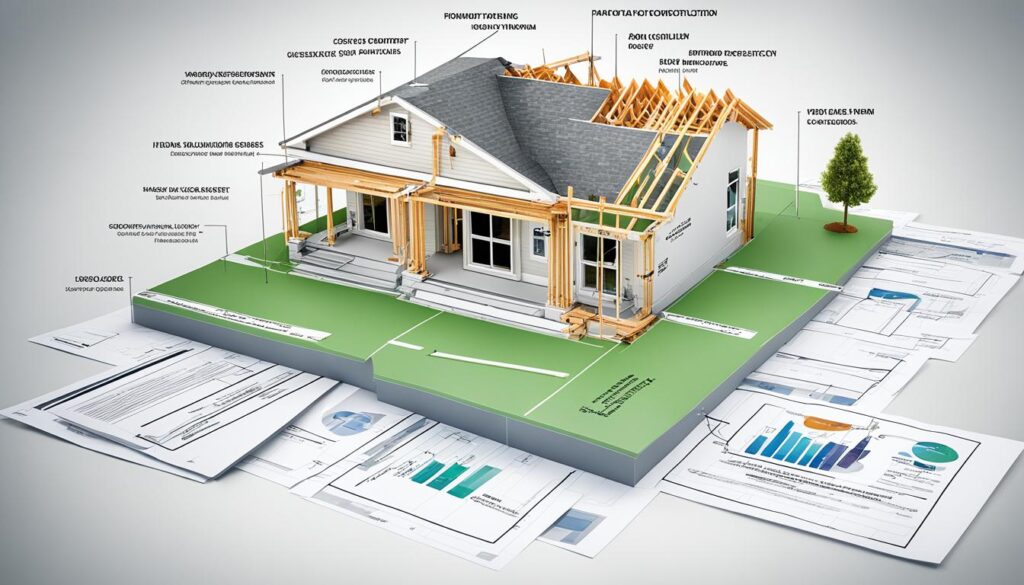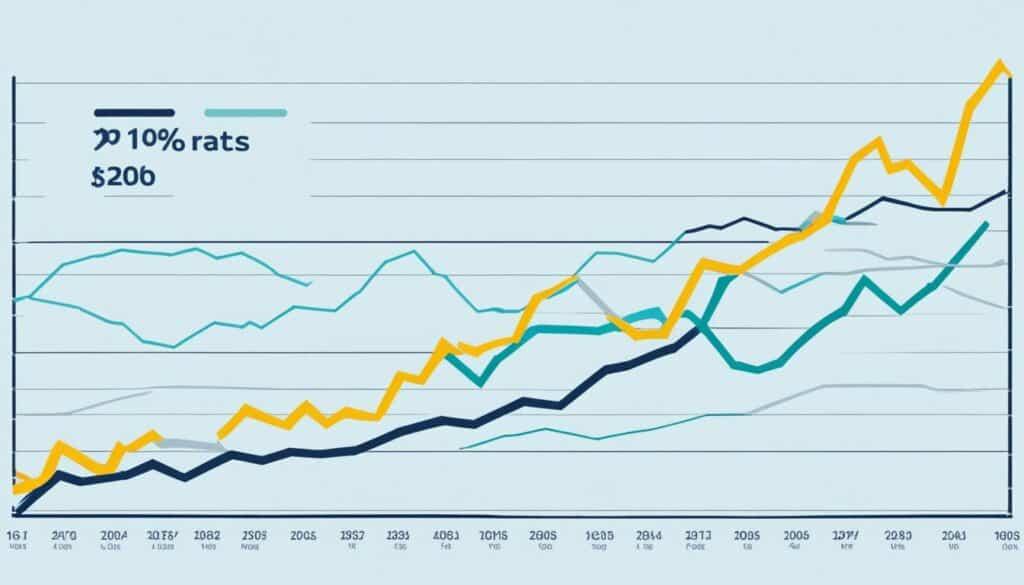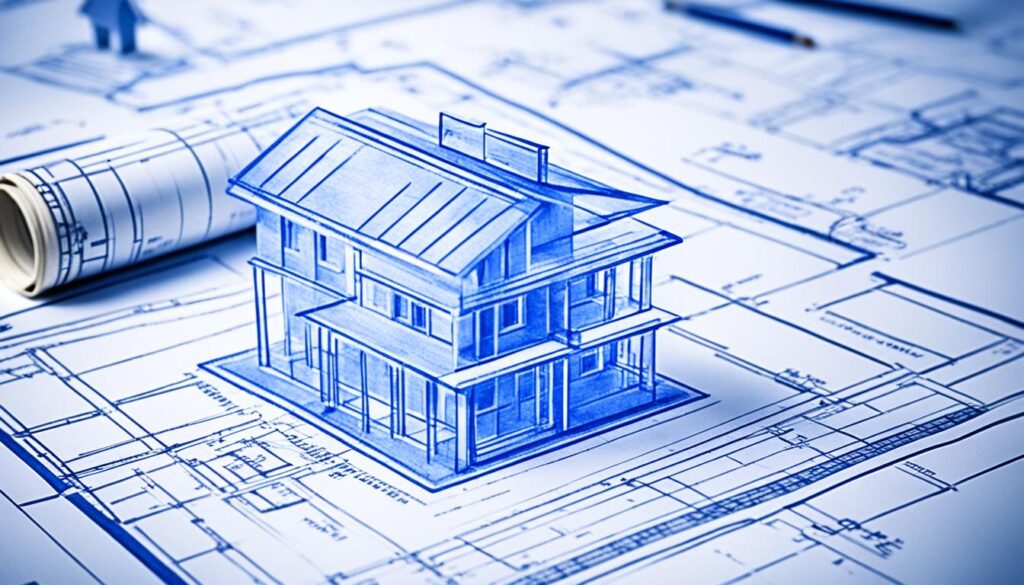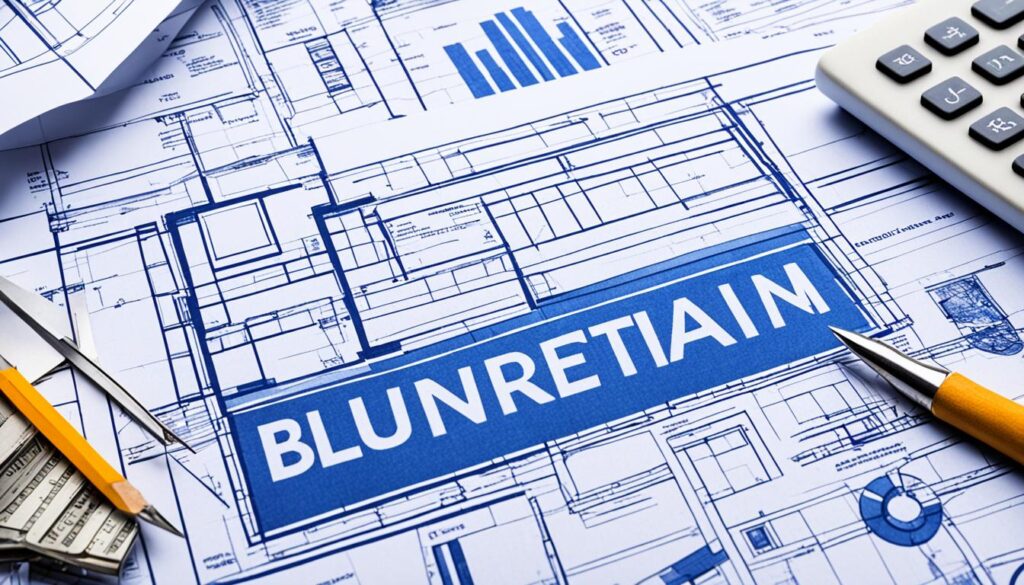Welcome to our comprehensive guide on securing competitive construction loan rates for builders and homeowners. Whether you’re a builder constructing multiple properties or a homeowner building your dream home, understanding the key factors that affect construction loan rates in 2024 is crucial. By familiarizing yourself with these factors, you can make informed decisions during the loan application process and ensure you get the best rates available.
Key Takeaways: construction loan rates
- Construction loan rates play a vital role in determining the affordability of building projects for both builders and homeowners.
- Factors such as loan term, credit score, inspection requirements, and project complexity can impact construction loan rates.
- Builders and homeowners need to qualify for construction loans by meeting specific criteria set by lenders.
- Understanding construction loan terms and different types of construction loans is essential for effective management.
- Taking strategic steps, such as working closely with loan officers and staying informed on mortgage rates, can help secure competitive loan rates.
What is a Construction Loan?
Before diving into construction loan rates, it’s important to understand what a construction loan is. A construction loan is a specialized mortgage that provides financing for home construction projects. It differs from a traditional mortgage as the loan amount is based on the projected cost of the construction, rather than the appraised value of a completed home. Construction loans typically have shorter terms, higher interest rates, and more detailed credit approval requirements.
Construction loans serve as a vital source of funding for individuals looking to build their dream homes. Whether you’re a builder or a homeowner, securing a construction loan is a pivotal step in realizing your vision for a new home.
One of the key distinctions between a construction loan and a traditional mortgage is the loan amount. While traditional mortgages are based on the appraised value of a completed home, construction loan amounts are determined by the projected cost of construction. This allows lenders to provide financing specific to the construction project, ensuring that the necessary funds are available throughout the building process.
The loan term for a construction loan is typically shorter compared to a traditional mortgage. This is due to the nature of home construction, which is often completed within a specified timeframe. As a result, construction loans may have terms ranging from a few months to a few years, depending on the complexity and duration of the project.
Interest rates for construction loans are generally higher than those for traditional mortgages. This is because construction loans carry a higher level of risk for lenders. The construction process involves various stages, and lenders need to account for potential delays and changes in market conditions. Higher interest rates serve as a protective measure for lenders, compensating them for the increased risk associated with construction loans.
Credit approval requirements for construction loans tend to be more detailed and stringent compared to traditional mortgages. Lenders evaluate the borrower’s creditworthiness, debt-to-income ratio, and construction plans to assess the viability of the project. A higher credit score is typically required to qualify for a construction loan, as it provides lenders with confidence in the borrower’s ability to manage the construction process and repay the loan.
Benefits of Construction Loans:
“Construction loans provide builders and homeowners with the necessary funds to bring their construction projects to life. By offering financing based on the projected cost of construction, construction loans enable borrowers to adequately budget and manage their financial resources throughout the building process. Despite higher interest rates and more detailed credit approval requirements, construction loans remain an invaluable tool for turning dreams into reality.”
Now that we have a solid understanding of what construction loans are, we can explore the intricacies of construction loan rates and the various factors that contribute to their determination. In the next section, we will delve into how construction loans work and the unique aspects of the loan process.
How Do Construction Loans Work?
Understanding the Borrower-Lender Relationship
Construction loans work differently from other types of loans and involve a unique relationship between the borrower and the lender. To begin the process, the borrower applies for a construction loan to cover the costs of building their home.
The Construction Period: Interest-Only Payments
During the construction period, which can last several months or even a year, the borrower typically makes interest-only payments. This allows them to focus on the construction process without the burden of full monthly payments.
Conversion to a Permanent Loan
Once the construction is complete, the construction loan converts into a permanent mortgage. This conversion is often referred to as a construction-to-permanent loan. Alternatively, the borrower may choose to obtain a separate permanent loan after the construction phase. In either case, the borrower transitions from the temporary construction loan to a long-term, permanent loan.
Throughout the construction loan process, it is crucial for the borrower to maintain a strong relationship with the lender. Clear communication and timely updates about the progress of the construction are essential for both parties involved.

Construction loans work as a bridge between the borrower’s vision for their dream home and its actual realization. The flexibility of interest-only payments during the construction period enables borrowers to manage their finances effectively while overseeing the construction process. The transition to a permanent loan ensures that the borrower has long-term financing for their completed home.
Factors That Affect Construction Loan Rates
When it comes to securing a construction loan, it’s important to understand the factors that can influence the interest rates offered by lenders. These factors play a significant role in determining the overall cost of borrowing for your construction project. Let’s explore the key elements that can impact construction loan rates:
- Loan Term: The duration of your loan, commonly known as the loan term, can affect the interest rates. Longer loan terms may come with higher interest rates, while shorter terms could offer more competitive rates.
- Credit Score: Your credit score is a crucial factor that lenders consider when determining loan rates. A higher credit score often translates to more favorable interest rates, as it reflects your creditworthiness and ability to repay the loan.
- Inspection: Lenders may require property inspections to assess the feasibility and quality of the construction project. Depending on the inspection findings, lenders may adjust the interest rates accordingly to mitigate potential risks.
- Loan Process: The complexity of the loan process, including documentation requirements and approval timelines, can impact construction loan rates. Smooth and efficient loan processes may result in more competitive rates.
- Closing Costs: Closing costs, which include fees associated with loan origination, appraisal, and other closing expenses, can influence loan rates. Higher closing costs may translate to slightly higher interest rates.
- Lot Loan: The type of loan you choose, such as a lot loan or a construction-only loan, can also affect construction loan rates. Different loan types may come with varying interest rates, so it’s essential to explore your options carefully.
By considering these factors when applying for a construction loan, you can make informed decisions and potentially secure more competitive interest rates. Keep in mind that every lender has their own criteria and considerations, so it’s important to shop around and compare offers to find the best loan terms for your specific project.

Qualifying for a Construction Loan
In order to qualify for a construction loan, it is important to meet the specific criteria set by the lender. One key requirement is having a credit score of at least 680. However, it’s worth noting that different lenders may have varying credit score requirements.
Fortunately, there are various loan programs available to cater to different types of construction projects. These programs provide flexibility and options for builders and homeowners seeking financing for their dream homes.
Securing credit approval is an essential step in the construction loan process. Lenders carefully review each applicant’s financial history and creditworthiness before granting approval for the loan. Demonstrating a strong credit profile and financial stability increases the chances of obtaining credit approval and securing a construction loan.
Benefits of Qualifying for a Construction Loan
Qualifying for a construction loan offers several benefits to builders and homeowners:
- Funding for your dream home: By meeting the lender’s criteria, you can access the necessary funds to build your dream home.
- Flexible loan programs: Different loan programs cater to various construction projects, providing tailored financing options.
- Construction budget confidence: Knowing that your credit is approved and the loan is secured allows you to move forward with confidence, ensuring your construction budget is on track.
Overall, qualifying for a construction loan is an important step in turning your vision of a dream home into a reality. By meeting the lender’s credit score requirements, exploring different loan programs, and obtaining credit approval, you can secure the financing needed to build the home you’ve always wanted.

Understanding Construction Loan Terms
Construction loan terms play a crucial role in the successful management of a construction loan. These terms encompass the specific conditions and arrangements related to the loan, ensuring that both builders and homeowners are aware of their responsibilities and expectations throughout the construction process.
Included in construction loan terms are:
- Disbursement: The process through which funds are distributed to cover the costs of construction-related expenses. Disbursement schedules outline when and how much money will be released to the borrower at specific stages of the project.
- Draw Schedule: A draw schedule outlines the milestones in the building process that trigger the release of funds from the construction loan. Each milestone achieved corresponds to a specific payment based on the project’s progress.
- Milestones in the Building Process: These represent significant stages of the construction project, such as completing the foundation, framing the structure, installing electrical and plumbing systems, and finishing interior details. Draw schedules are often structured around these milestones.
- Construction Financing: Refers to the financial arrangements and mechanisms put in place to facilitate the construction project. Construction financing includes the loan terms, draw schedules, and other financial considerations specific to the construction loan.
Understanding these construction loan terms is vital for both builders and homeowners to effectively plan and manage their construction loan. Additionally, it helps ensure a smooth flow of funding throughout the building process, allowing the project to progress efficiently while staying within the allocated budget.

How Construction Loan Terms Impact the Building Process
“By clearly outlining the disbursement and draw schedule, construction loan terms provide a framework for managing cash flow and ensuring timely payments to contractors and suppliers. These terms also serve as a guide for builders to monitor and track progress, helping them meet key construction milestones and deliver the project on time.”
Construction loan terms are legally binding agreements between the borrower and the lender, setting forth the terms and conditions governing the loan. They provide a roadmap for the construction process, ensuring that the necessary funds are available at the appropriate stages. Knowledge of construction loan terms empowers builders and homeowners to make informed decisions, address potential challenges, and successfully navigate the construction loan process.
| Term | Description |
|---|---|
| Disbursement | The process of releasing funds to cover construction-related expenses. |
| Draw Schedule | A schedule that determines when funds are released based on project milestones. |
| Milestones in the Building Process | Significant stages of construction, such as foundation completion or framing. |
| Construction Financing | The financial arrangements and mechanisms supporting the construction project. |
Effective communication and collaboration between builders, homeowners, and the lender are essential for ensuring that construction loan terms are understood and followed. By adhering to these terms, all parties involved can work together harmoniously to achieve the desired outcome: the successful completion of a dream home.
Types of Construction Loans
When it comes to financing construction projects, different types of construction loans are available to cater to various needs. Whether you’re a builder or a homeowner, understanding these loan options can help you make informed decisions. Let’s explore the common types of construction loans:
Builder’s Loan
A builder’s loan is specifically designed for builders and contractors. With this type of loan, funds are disbursed directly to the builder at regular intervals throughout the construction process. The builder can use these funds to cover the costs of materials, labor, and other expenses associated with the project. This loan option offers convenience and flexibility to builders, ensuring a streamlined financing process.
Owner-Builder Loans
Owner-builder loans are ideal for homeowners who want to take a more hands-on approach to the construction process. With this type of loan, the homeowner acts as the builder, overseeing the construction project themselves or hiring subcontractors. Owner-builder loans provide the freedom to have complete control over the construction, allowing homeowners to customize their dream homes according to their preferences.
Construction-Only Loans
Construction-only loans, also known as interim loans or short-term construction loans, are used solely for financing construction expenses. These loans provide the necessary funds to cover construction costs until the project is completed. Once the construction phase is finished, borrowers often convert the construction-only loan into a permanent mortgage or obtain a separate permanent loan for the completed home. Construction-only loans are an excellent option for those who already own the land and need funding for construction.
Each type of construction loan serves a specific purpose, catering to different requirements. by understanding the options available, builders and homeowners can choose the loan that best aligns with their needs and goals.

Compare Different Types of Construction Loans
| Loan Type | Purpose | Disbursement Method | Borrower’s Role |
|---|---|---|---|
| Builder’s Loan | Financing for builders and contractors | Direct disbursement to the builder | Contractor or builder |
| Owner-Builder Loan | Financing for homeowners taking a hands-on approach | Direct disbursement to the homeowner | Homeowner acts as the builder |
| Construction-Only Loan | Financing solely for construction expenses | Funds released in installments | Borrower is responsible for overseeing construction |
Tips for Securing Competitive Construction Loan Rates
Builders and homeowners who aspire to secure competitive construction loan rates can follow these valuable tips:
- Work closely with a knowledgeable loan officer: Collaborating with an experienced loan officer is crucial for navigating the complex world of construction loans. A loan officer can guide you through the process, help you understand the intricacies of construction loan rates, and assist in finding the best financing options available.
- Stay informed about mortgage rates: Keeping track of current mortgage rates is essential when seeking competitive construction loan rates. By staying updated, builders and homeowners can make informed decisions and take advantage of favorable market conditions.
- Consider interest-only payment options: During the construction period, builders and homeowners may have the option to make interest-only payments. This can help to manage cash flow and minimize financial strain during the construction phase.
- Assess the possibility of refinancing: Once construction is complete, builders and homeowners can explore the potential for refinancing their construction loan into a better loan with lower interest rates or more favorable terms. This assessment should be conducted in consultation with a loan officer.
By applying these strategies, builders and homeowners can increase their chances of securing competitive construction loan rates and ultimately realize their dream homes.
Tips for Choosing the Right Loan Officer
When searching for a loan officer, consider the following factors:
- Experience in construction loans
- Expertise in the local market
- Strong communication and responsiveness
- Favorable client reviews and testimonials
Choosing the right loan officer is crucial for a smooth loan application process and securing the most competitive construction loan rates.
“A knowledgeable loan officer can be your trusted guide in navigating the world of construction loan rates.”
The Construction Loan Process: From Application to Disbursement
Securing a construction loan involves going through a step-by-step process that spans from the initial application to the disbursement of funds. This section will outline each stage, highlighting the key aspects of the loan process and providing valuable insights for builders and homeowners.
1. Application
The first step in obtaining a construction loan is to complete the application process. Builders and homeowners need to provide detailed information about their project, including the estimated costs, construction plans, and timeline. Lenders will also require financial documentation, such as proof of income and credit history.
2. Review and Approval
Once the application is submitted, the lender will review it along with the supporting documentation. This stage may involve a thorough evaluation of the borrower’s creditworthiness, construction experience, and financial stability. The lender will assess the feasibility of the project and determine whether the borrower qualifies for the loan.
3. Loan Documentation
If the application is approved, the next step is to finalize the loan documentation. This includes the loan agreement, which outlines the terms and conditions of the loan, such as the interest rate, repayment schedule, and any additional fees or requirements. It is crucial for borrowers to carefully review and understand these documents before signing.
4. Construction Begins
Once the loan is approved and the documentation is in place, construction can commence. Builders and homeowners can start working on their dream home, knowing that the funds for the project are secured. During this phase, it is essential to adhere to the construction plans and timelines outlined in the loan agreement.
5. Disbursement of Funds
Throughout the construction process, the lender will disburse funds at various intervals, based on predetermined milestones or stages of completion. Draw inspections may be conducted to ensure the construction progress aligns with the loan agreement. Builders and homeowners must keep accurate records of expenses and provide necessary documentation for each draw request.
6. Loan Conversion
Once the construction is complete, the construction loan typically converts into a permanent mortgage, or the borrower obtains a separate permanent loan. This conversion allows borrowers to transition from the temporary construction loan to a long-term financing solution that suits their needs.
Having construction experience can be advantageous when navigating the construction loan process. It enables builders and homeowners to understand the intricacies of the construction industry, communicate effectively with contractors and lenders, and ensure that the project stays on track.
Remember to consult with a knowledgeable loan officer who specializes in construction loans. They can guide you through the process, provide valuable insights, and help you secure the most competitive construction financing rates available.
Also Read:- Get Insights On The Massachusetts Institute Of Technology
Conclusion
In conclusion, understanding construction loan rates is crucial for both builders and homeowners. Various factors, such as market trends and loan options, can significantly impact these rates. By staying informed about current market trends and exploring different loan options, borrowers can make informed decisions when applying for construction loans. It is also essential to work with experienced professionals, such as lenders and loan officers, who can provide guidance and support throughout the loan application process.
Moreover, market trends play a vital role in construction loan rates. By keeping an eye on market conditions, borrowers can anticipate potential fluctuations in rates and plan accordingly. This knowledge can help homeowners and builders secure the most favorable rates for their dream homes, ensuring that the loan terms align with their financial goals and expectations.
In summary, construction loan rates are influenced by various factors, including market trends and available loan options. By understanding these factors and working with industry professionals, borrowers can navigate the loan application process successfully and secure competitive rates. Whether you are a builder or a homeowner, taking the time to research and stay informed about construction loan rates is key to achieving your construction project goals.
FAQs
Q: What is a construction loan?
A: A construction loan is a short-term loan that is used to finance the building of a new home or major renovations on an existing property.
Q: How do construction loan rates differ from traditional mortgage rates?
A: Construction loan rates tend to be higher than traditional mortgage rates since they are considered riskier loans for lenders.
Q: What is a construction-to-permanent loan?
A: A construction-to-permanent loan is a type of loan that allows you to finance the construction of your home and then convert it into a traditional mortgage once the construction is complete.
Q: How can I apply for a construction loan?
A: To apply for a construction loan, you will need to provide detailed plans and cost estimates for the project, as well as your financial information to the lender.
Q: What are the different types of construction loan options available?
A: There are various types of construction loans, including construction-to-permanent loans, lot loans, and renovation loans, each tailored to different building needs.
Q: What is the typical construction period for a new home?
A: The construction period for a new home is usually around 12 months, during which the funds from the construction loan are used to cover the building expenses.
Q: What is the role of a credit union in providing construction loans?
A: Credit unions can be a good option for obtaining construction loans as they often offer competitive rates and personalized service to their members.





